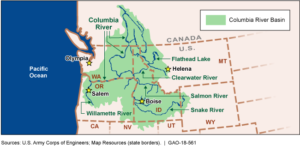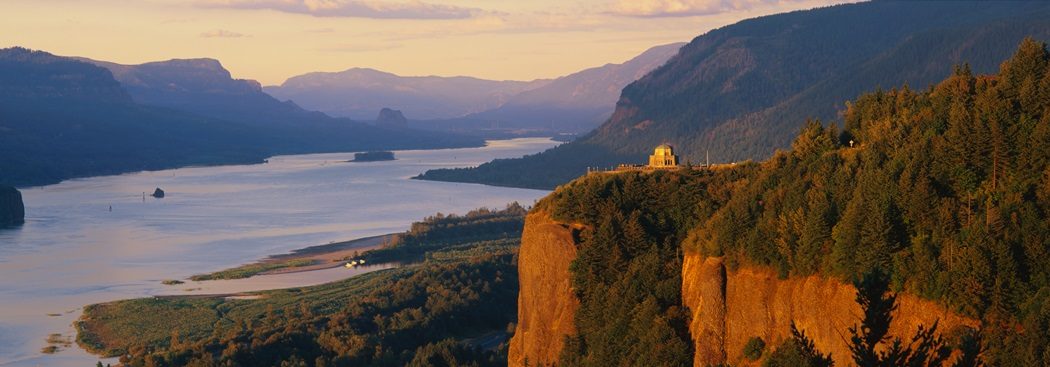Activities such as hydropower and agricultural practices have impaired water quality in parts of the Columbia River Basin. This has put human health at risk and threatened the existence of some wildlife species, such as salmon.
In a new report, the U.S. Government Accountability Office (GAO) found that federal and state agencies, tribes and others have taken steps to improve Basin water quality.
However, the U.S. Environmental Protection Agency and the Office of Management and Budget have yet to take actions required under a 2016 amendment to the Clean Water Act.
EPA, for example, has not begun a program to oversee and help coordinate restoration efforts.
What GAO Found:
 Various entities, including federal and state agencies and tribes, implemented restoration efforts to improve water quality in the Columbia River Basin from fiscal years 2010 through 2016, according to GAO survey results.
Various entities, including federal and state agencies and tribes, implemented restoration efforts to improve water quality in the Columbia River Basin from fiscal years 2010 through 2016, according to GAO survey results.
Entities implemented a range of restoration efforts. Efforts included activities to improve surface water quality and restore and protect habitat.
For example, the Kootenai Tribe of Idaho implemented projects on the Kootenai River to restore and maintain conditions that support all life stages of native fish.
Entities used various collaborative approaches. Entities’ approaches to collaboration for selected water quality-related efforts in the Basin varied. For example, the Environmental Protection Agency (EPA) sought various entities’ voluntary involvement to coordinate toxics reduction efforts in the Basin.
Total federal expenditures could not be determined. Entities reported using a mix of federal and nonfederal funding sources for restoration efforts in the Basin, but total federal expenditures could not be determined, in part because there is no federal funding dedicated to restoring the Basin.
EPA and Office of Management and Budget (OMB) have not yet implemented Section 123. According to EPA officials, the agency has not yet taken steps to establish the Columbia River Basin Restoration Program, as required by the Clean Water Act Section 123. EPA officials told GAO they have not received dedicated funding appropriated for this purpose; however, EPA has not yet requested funding to implement the program or identified needed resources.
By developing a program management plan that identifies actions and resources needed, EPA would have more reasonable assurance that it can establish the program in a timely manner. Also, an interagency crosscut budget has not been submitted. According to OMB officials, they have had internal conversations on the approach to develop the budget but have not requested information from agencies. A crosscut budget would help ensure Congress is better informed as it considers funding for Basin restoration efforts.
Why GAO Did This Study:
The Basin is one of the nation’s largest watersheds and extends mainly through four Western states and into Canada. Activities such as power generation and agricultural practices have impaired water quality in some areas, so that human health is at risk and certain species, such as salmon, are threatened or extinct. In December 2016, Congress amended the Clean Water Act by adding Section 123, which requires EPA and OMB to take actions related to restoration efforts in the Basin.
GAO was asked to review restoration efforts in the Basin. This report examines (1) efforts to improve water quality in the Basin from fiscal years 2010 through 2016; (2) approaches to collaboration that entities have used for selected efforts; (3) sources of funding and federal funding expenditures; and (4) the extent to which EPA and OMB have implemented Clean Water Act Section 123. GAO reviewed documentation, including laws, policies, and budget information; surveyed federal, state, tribal, and nongovernmental entities that GAO determined had participated in restoration efforts; and conducted interviews with officials from most of these entities.
What GAO Recommends:
GAO is making three recommendations, including that EPA develop a program management plan for implementing the Columbia River Basin Restoration Program and that OMB compile and submit an interagency crosscut budget. EPA agreed with its recommendation. OMB did not comment, and GAO maintains its recommendations are valid.
Recommendations for Executive Action:
- Recommendation #1: The Administrator of the EPA should develop a program management plan that includes a schedule of the actions EPA will take and the resources and funding it needs to establish and implement the Columbia River Basin Restoration Program, including formation of the associated Columbia River Basin Restoration Working Group, and submit this plan to the appropriate congressional authorizing committees as part of the fiscal year 2020 budget process. (Recommendation 1). Agency Affected: Environmental Protection Agency
- Recommendation #2: The Director of OMB should develop and provide guidance on the types of projects and activities that agencies involved in the protection and restoration of the Columbia River Basin should include in their reports, as well as the processes they should follow in compiling the related budget and spending information. (Recommendation 2). Agency Affected: Executive Office of the President: Office of Management and Budget
- Recommendation #3: The Director of OMB should direct each federal agency involved in the protection and restoration of the Columbia River Basin to collect the information OMB needs for the interagency crosscut budget and to submit this information to OMB for inclusion in the interagency crosscut as part of the President’s budget request for fiscal year 2020. (Recommendation 3). Agency Affected: Executive Office of the President: Office of Management and Budget
Featured photo (via Adobe Stock) shows Crown Point (also known as Woman’s View) overlooking the Columbia River at sunset.
For more information, contact Alfredo Gómez at (202) 512-3841 or gomezj@gao.gov.

